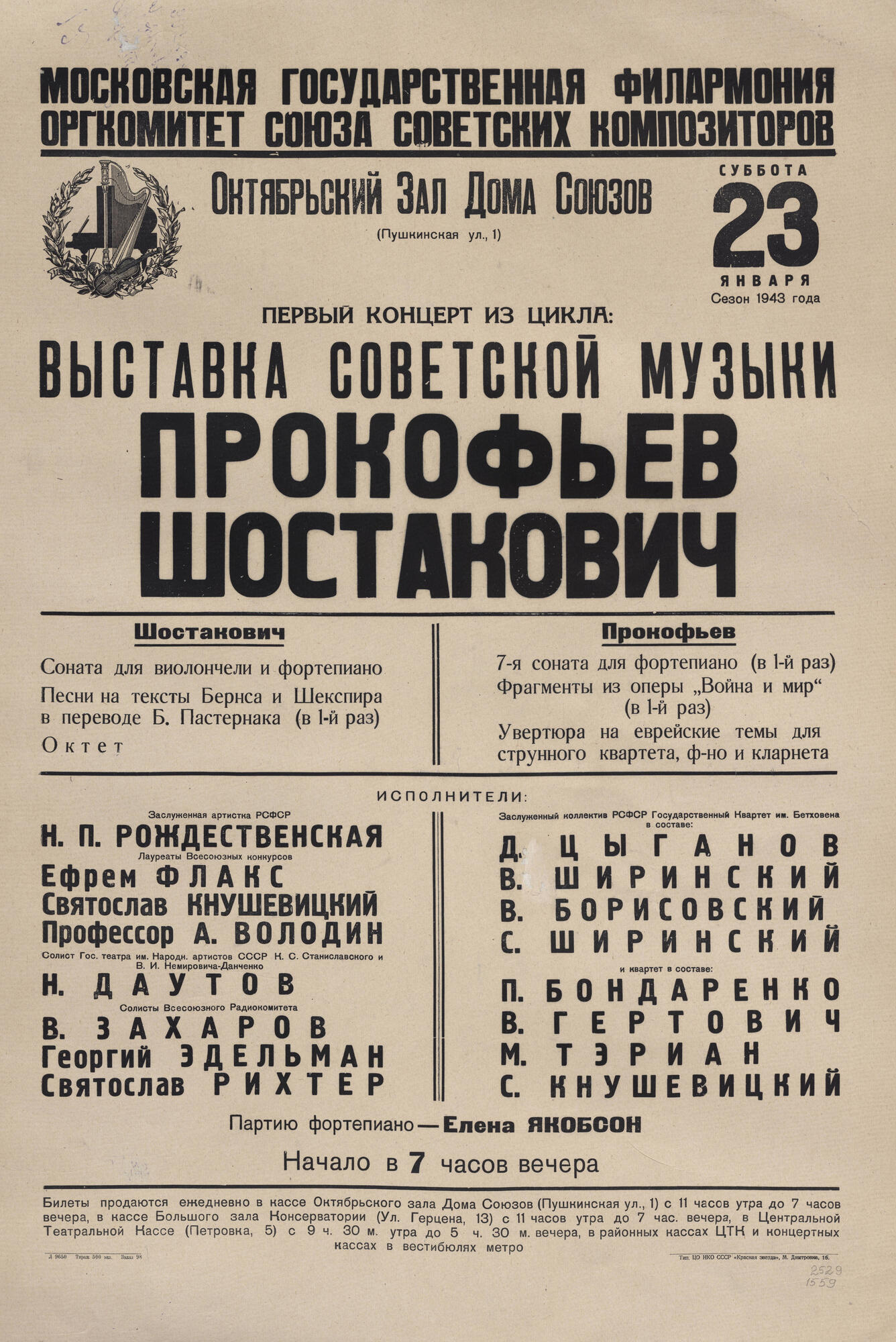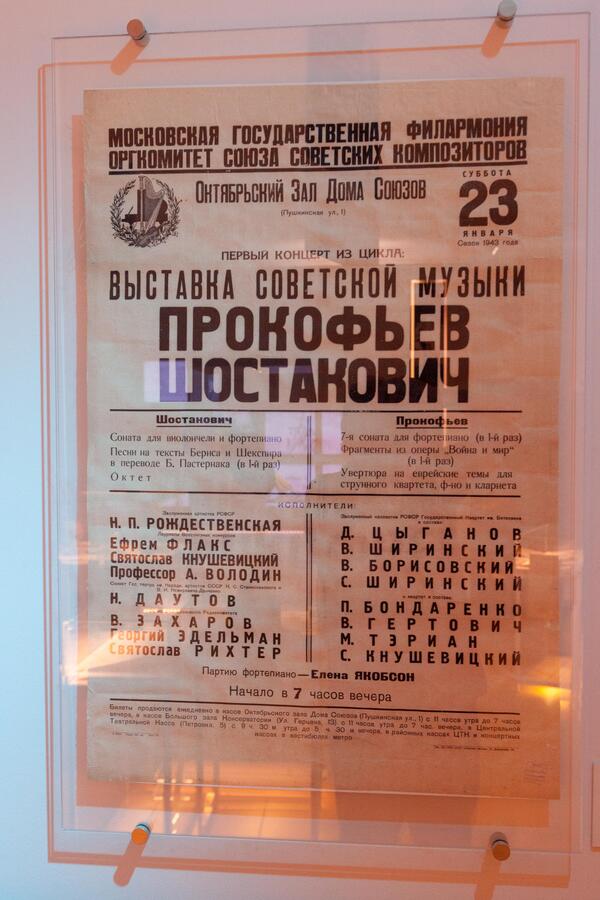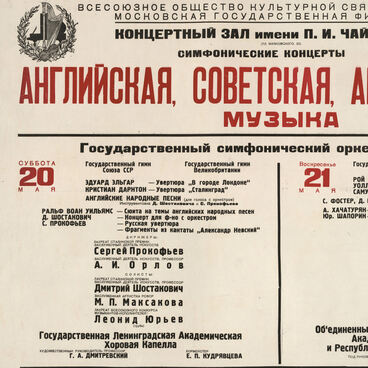The concert at the October Hall of the House of the Unions took place on January 23, 1943. The program featured the premiere of the Seventh Sonata by Sergei Prokofiev, as well as the songs of Dmitri Shostakovich on the texts of Robert Burns and William Shakespeare (from the series of songs on the verses of English poets for bass and piano, op. 62).
That evening, the musicians also performed Prokofiev’s “Overture on Hebrew Themes”, as well as Sonata for Cello and Piano and the String Octet by Shostakovich. The program on the poster includes fragments of Prokofiev’s opera “War and Peace” but these pieces were not performed because the singer Natalya Rozhdestvenskaya was ill. The concert was visited by the violinist David Oistrakh, the conductor Nikolai Anosov, the composers Nikolai Miaskovsky, Vissarion Shebalin, and Anatoly Alexandrov.
The Seventh Sonata was performed by Sviatoslav Richter, who was at the time a young pianist and would later become a world-famous musician and a friend of Prokofiev. Richter learned an extremely difficult 31-page-long sonata in only four days. He admitted, “They say the sonata is difficult, and it actually is, but the music seems to flow directly into my hands.” Before the concert, Richter played the sonata through for the composer. Prokofiev approved of his performance saying, “Great job! This is the first time I have truly heard this sonata.”
The premiere was a triumphant success, and Prokofiev was called back again and again. After the end of the concert, the audience started filing out, and Prokofiev and his second wife Mira Mendelson-Prokofieva were already backstage putting on their coats. However, the listeners enjoyed the sonata so much that a few of them remained behind and asked the performer to repeat it for them.
The Seventh Sonata belongs to a so-called “military triad” of Prokofiev’s piano sonatas which include the Sixth, Seventh, and Eighth Sonatas. During the war, Prokofiev returned to this genre for the first time in fifteen years. The idea came to him while he was reading Romain Rolland’s book on Ludwig van Beethoven, the Viennese composer who wrote 32 sonatas. Prokofiev composed the Seventh Sonata over the period between 1939 and 1942. Miaskovsky referred to the sonata as being “wonderfully wild”, while Richter described it as “disorder and uncertainty”, “the raging of death-dealing forces”, “the fullness of feeling”, and “a headlong running attack full of a will for victory.”
That evening, the musicians also performed Prokofiev’s “Overture on Hebrew Themes”, as well as Sonata for Cello and Piano and the String Octet by Shostakovich. The program on the poster includes fragments of Prokofiev’s opera “War and Peace” but these pieces were not performed because the singer Natalya Rozhdestvenskaya was ill. The concert was visited by the violinist David Oistrakh, the conductor Nikolai Anosov, the composers Nikolai Miaskovsky, Vissarion Shebalin, and Anatoly Alexandrov.
The Seventh Sonata was performed by Sviatoslav Richter, who was at the time a young pianist and would later become a world-famous musician and a friend of Prokofiev. Richter learned an extremely difficult 31-page-long sonata in only four days. He admitted, “They say the sonata is difficult, and it actually is, but the music seems to flow directly into my hands.” Before the concert, Richter played the sonata through for the composer. Prokofiev approved of his performance saying, “Great job! This is the first time I have truly heard this sonata.”
The premiere was a triumphant success, and Prokofiev was called back again and again. After the end of the concert, the audience started filing out, and Prokofiev and his second wife Mira Mendelson-Prokofieva were already backstage putting on their coats. However, the listeners enjoyed the sonata so much that a few of them remained behind and asked the performer to repeat it for them.
The Seventh Sonata belongs to a so-called “military triad” of Prokofiev’s piano sonatas which include the Sixth, Seventh, and Eighth Sonatas. During the war, Prokofiev returned to this genre for the first time in fifteen years. The idea came to him while he was reading Romain Rolland’s book on Ludwig van Beethoven, the Viennese composer who wrote 32 sonatas. Prokofiev composed the Seventh Sonata over the period between 1939 and 1942. Miaskovsky referred to the sonata as being “wonderfully wild”, while Richter described it as “disorder and uncertainty”, “the raging of death-dealing forces”, “the fullness of feeling”, and “a headlong running attack full of a will for victory.”



